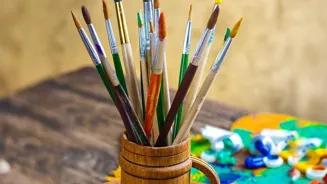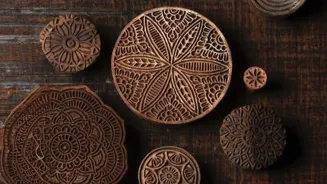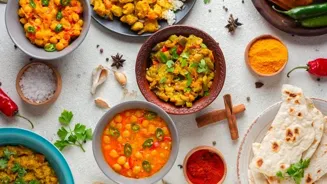Unveiling the Magic of Indian Handicrafts: 7 Talented Artisans Await Your Discovery! Dive in to preserve a legacy
India, a land brimming with culture and heritage, finds its soul in its handicrafts. These
are not merely objects; they are stories woven in thread, sculpted in clay, and painted with the vibrant colors of our diverse traditions.
From the snow-capped Himalayas to the sun-kissed beaches of the south, each region boasts its unique craft, passed down through generations of skilled artisans. But in this age of mass production and fleeting trends, the survival of these ancient art forms is under threat.
It's time we, as conscious consumers, step up and support the hands that create these treasures. This article shines a spotlight on seven exceptional artisans and their crafts, urging you to discover the magic they bring to life and contribute to preserving India's rich artistic legacy.
Indian handicrafts: diverse art reflecting regional identity, cultural narratives, and heritage
The world of Indian handicrafts is a kaleidoscope of artistry, each piece reflecting a unique regional identity and cultural narrative.
Imagine finely woven Pashmina shawls from Kashmir, so soft they feel like a cloud against your skin, or intricately carved wooden toys from Channapatna, bursting with playful colors.
Think of the delicate blue pottery of Jaipur, narrating tales through its intricate floral patterns, or the robust terracotta pottery of West Bengal, echoing the earthy essence of the soil, or the mesmerizing Ajrakh block prints from Gujarat and Rajasthan, displaying the ancient process of printing.
These are not mere commodities; they are tangible pieces of our heritage, crafted with love, dedication, and extraordinary talent. By choosing to purchase handcrafted goods, we not only bring beauty into our lives but also empower these talented individuals and sustain their livelihoods.
Exploring Indian handicrafts with artisans preserving traditional techniques
Let's journey through the diverse landscape of Indian handicrafts and meet some of the artisans who are keeping these traditions alive.
First, we have Fatima Bi, a master weaver from Bhujodi village in Gujarat, who meticulously creates vibrant woolen shawls and rugs using traditional techniques passed down through her family for generations.
Each piece tells a story, with intricate geometric patterns and natural dyes reflecting the rich cultural heritage of the Kutch region. Then there is Ram Singh, a Channapatna toy maker from Karnataka, whose wooden toys, painted with bright natural colors, bring joy to children and adults alike.
He is dedicated to preserving the traditional techniques of lacquerware, ensuring that the art form continues to thrive. Third lets talk about, Sita Devi, from Rajasthan. She is a skilled potter preserving the age old techniques of creating pottery.
Meet artisans across India specializing in unique crafts
Continuing our journey, we encounter Mohammad Yusuf, a master artisan from Jaipur, Rajasthan. He creates beautiful blue pottery, from plates to vases. The intricate floral designs and the distinctive blue glaze of his creations have made Jaipur pottery famous worldwide.
Yusuf is committed to using traditional techniques and natural materials, ensuring the authenticity of his work. These pieces add a touch of elegance and history to any home. We then travel to West Bengal, to meet with artisanal families who are dedicated to terracotta artwork.
Now moving towards the east, we shall meet artisans of Assam who specialises in cane and bamboo work. These artisans weave intricate baskets, furniture, and decorative items using sustainable materials, showcasing the natural beauty of the region.
Artisans face challenges from imitations, low wages, market access, and skill erosion
It's crucial to understand the challenges faced by these artisans. Mass-produced imitations, often made with cheaper materials and devoid of the artistry and soul of the original, flood the market.
This undercuts the prices of genuine handicrafts, making it difficult for artisans to earn a fair wage and compete. In addition, the lack of access to markets, inadequate infrastructure, and limited financial resources further exacerbate their struggles.
Many younger generations are turning away from these traditional crafts, seeking more lucrative employment opportunities in urban areas, leading to a gradual erosion of these invaluable skills. Without adequate support, these crafts are in danger of disappearing altogether.
Support artisans directly or indirectly to preserve Indian handicrafts
How can you, as a conscious consumer, make a difference? The answer is simple: choose to support these artisans directly or indirectly. Seek out handcrafted goods from reputable sources, such as craft fairs, government emporiums, or online platforms that connect artisans directly with consumers.
Be willing to pay a fair price that reflects the skill, labor, and artistry involved in creating these unique pieces. Educate yourself about the stories behind the crafts and share your knowledge with others, raising awareness about the importance of preserving these traditions.
Advocate for policies that support artisans, such as access to finance, training programs, and marketing assistance. By taking these steps, you can play a vital role in ensuring the survival of Indian handicrafts and the livelihoods of the artisans who create them.
Support artisans for heritage & tradition preservation
Let's celebrate and support these artisans, not just for the beauty of their creations, but for the cultural heritage they represent. By choosing handmade, we are not just buying a product, we are investing in a tradition, supporting a livelihood, and preserving a piece of India's soul.
Let's make a conscious choice to keep these art forms alive, ensuring that future generations can also witness and appreciate the magic of Indian handicrafts.
AI Generated Content. Glance/InMobi shall have no liability for the content









